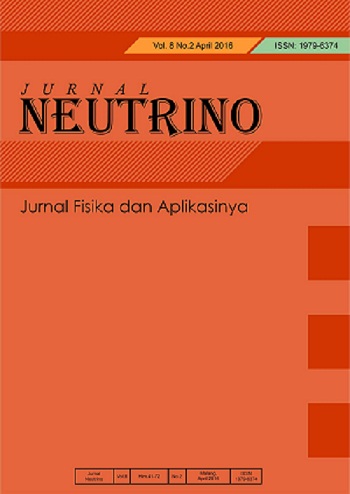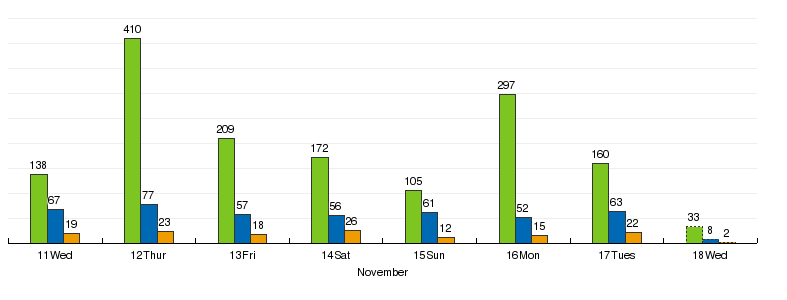CHARACTERIZATION AND EFFECTIVENESS OF MORINGA OLEIFERA SEEDS EXTRACT AS A PHOSPHATE COAGULANT
Abstract
In this research, Moringa oleifera seeds extract has been shown the ability as a coagulation agent. The molecules that act as the coagulation agents were the proteins which were obtained by the extraction process of the Moringa seeds using NaCl solution. The aim of this research was to characterize and test the effectiveness of the Moringa seeds extract as a phosphate coagulant. The determination of the coagulation process was carried out using a Jar Test method of phosphate solution samples, and then effectiveness the samples were analyzed using a UV-Vis spectroscopy after-treatment of the coagulant dose variations, depositional time, and the pH variations of the samples. The characterization of the extract functional groups was determined using an FTIR spectroscopy. The results of the coagulation phosphate sample examinations showed that the optimum dose of the coagulant was 80 mL/L, with a decrease in the initial phosphate concentration of 17 ppm to 13.58 ppm. The reduction effect of precipitation time and pH also was obtained in this research. The optimum precipitation time and pH were in 30 minutes and pH 8, which reduced the phosphate concentration to 11.697 and 9.6 ppm, respectively. The FTIR spectra of Moringa oleifera seeds extracts before and after interacting with phosphate showed their differences. The interactions between the extract and phosphate were demonstrated by the appearance of buckling vibrations at wavenumbers 1064.2 cm-1, 799.8 cm-1, and 668.8 cm-1. The results of this study indicated that the Moringa seeds extraction with NaCl has potential as a phosphate coagulation agent.
Keywords
Full Text:
PDFReferences
Panasiuk, O. Phosphorus removal and recovery from wastewater using magnetite. 2010.
Bunce, J. T., Ndam, E., Ofiteru, I. D., Moore, A., & Graham, D. W. A review of phosphorus removal technologies and their applicability to small-scale domestic wastewater treatment systems. Front. Environ. Sci.. 2018;6(8).
Amagloh, F. K. & Benang, A. Effectiveness of Moringa oleifera seed as coagulant for water purification. 2009.
Sánchez-Martín, J., Beltrán-Heredia, J. & Peres, J. Improvement of the flocculation process in water treatment by using Moringa oleifera seeds extract. Braz. J. Chem. Eng..2012; 29(3): 495–502
Aslamiah, S. S., Yulianti, E. & Jannah, A. Aktivitas koagulasi Ekstrak Biji Kelor (Moringa oleifera L.) dalam Larutan NaCl terhadap Limbah Cair IPAL PT. Sier Pier Pasuruan. ALCHEMY.2013; 2(3):178-183
Okuda, T., Baes, A. U., Nishijima, W. & Okada, M. Isolation and characterization of coagulant extracted from Moringa oleifera seed by salt solution. Water research. 2001; 35(2): 405–410
Okuda, T., Baes, A. U., Nishijima, W. & Okada, M. Improvement of extraction method of coagulation active components from Moringa oleifera seed. Water research. 1999; 33(15): 3373–3378
Winarno, F. Kimia Pangan dan Gizi, Jakarta. Jakarta; PT Gramedia Pustaka Utama; 2002.
Gultom, O. W., Lestari, S. & Nopianti, R. Analisis proksimat, protein larut air, dan protein larut garam pada beberapa jenis ikan air tawar Sumatera Selatan. Jurnal FishtecH. 2015; 4(2): 120-127.
Rizqi, W., Yulianti, E. & Jannah, A. Utilization of NaCl Solution of Moringa Oleifera Seed Extract as Natural Coagulant at Liquid Waste at PT. Cheil Jedang Indonesia–Jombang. ALCHEMY. 2018;4(1):60–66.
Khasanah, U. Efektifitas biji kelor (Moringa Oleifera, LAMK) sebagai koagulan fosfat dalam limbah cair rumah sakit: Studi kasus di RSU Dr. Saiful Anwar Malang [Skripsi]. Malang: Universitas Islam Negeri Maulana Malik Ibrahim; 2008.
Cornel, P. & Schaum, C. Phosphorus recovery from wastewater: needs, technologies and costs. Water Sci. Technol. 2009;59(6): 1069–1076.
Oleszkiewicz, J., Kruk, D., Devlin, T., Lashkarizadeh, M. & Yuan, Q. Options for improved nutrient removal and recovery from municipal wastewater in the Canadian context. Winn. MN Can: Water Netw; 2015.
Pernitsky, D. J. & Eng, P. Coagulation 101. in Proceedings, Technology Transfer Conference, Universidade de Calgary: Alberta, Canadá; 2003.
Hidayat, S. Pemberdayaan Masyarakat Bantaran Sungai Lematang dalam Menurunkan Kekeruhan Air dengan Biji Kelor (Moringa oleifera Lam.) sebagai Upaya Pengembangan Proses Penjernihan Air [Disertasi]. Program Studi Pendidik. Biol. Univ. Negeri Malang: Malang; 2006.
Ostolska I, Wiśniewska M. Application of the zeta potential measurements to explanation of colloidal Cr 2 O 3 stability mechanism in the presence of the ionic polyamino acids. Colloid and polymer science. 2014 Oct 1;292(10):2453-64.
Nouhi S. Structure formation at solid/liquid interfaces: Understanding self-assembly and environmental challenges [PhD thesis]. Acta Universitatis Upsaliensis; 2018
Socrates G. Infrared and Raman characteristic group frequencies: tables and charts. John Wiley & Sons; 2004 Jun 18.
DOI: https://doi.org/10.18860/neu.v12i2.8369
Refbacks
- There are currently no refbacks.
Copyright (c) 2020 Nishfu Sya’banah, Eny Yulianti, Vina Nurul Istighfarini, Fadilah Nor Laili Lutfia

This work is licensed under a Creative Commons Attribution-NonCommercial-ShareAlike 4.0 International License.
Published By:
Program Studi Fisika Fakultas Sains dan Teknologi Universitas Islam Negeri (UIN) Maulana Malik Ibrahim Malang, Indonesia
B.J. Habibie 2nd Floor
Jl. Gajayana No.50 Malang 65144
Telp./Fax.: (0341) 558933
Email: neutrino@uin-malang.ac.id
This work is licensed under a Creative Commons Attribution-NonCommercial-ShareAlike 4.0 International License
View My Stats










